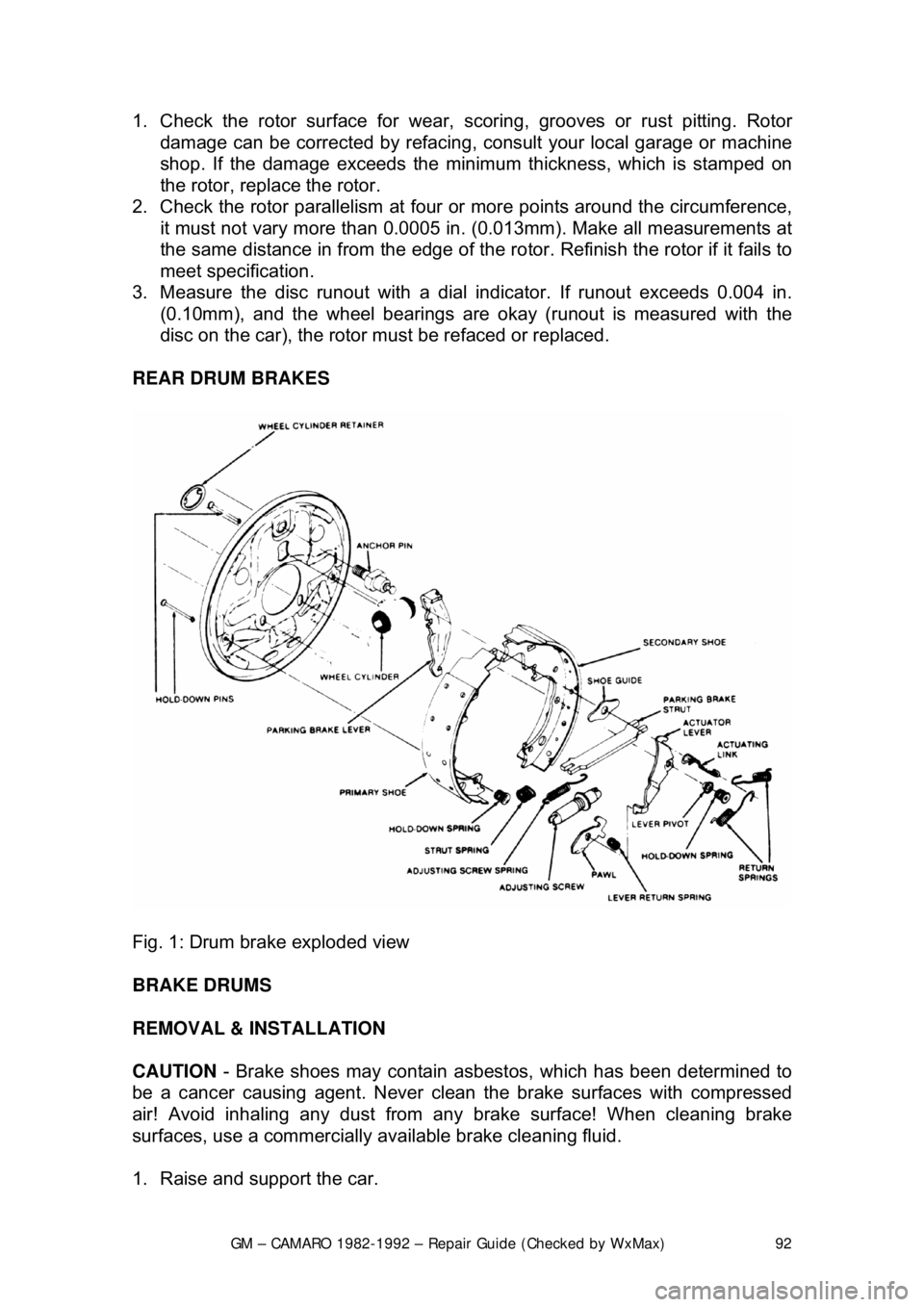Page 92 of 875

GM – CAMARO 1982-1992 – Repair Guide (Checked by WxMax) 92
1. Check the rotor surface for wear, sco
ring, grooves or rust pitting. Rotor
damage can be corrected by refacing, cons ult your local garage or machine
shop. If the damage exceeds the minimu m thickness, which is stamped on
the rotor, replace the rotor.
2. Check the rotor parallelism at four or more points around the circumference,
it must not vary more than 0.0005 in . (0.013mm). Make all measurements at
the same distance in from the edge of the ro tor. Refinish the rotor if it fails to
meet specification.
3. Measure the disc runout with a dial indicator. If runout exceeds 0.004 in.
(0.10mm), and the wheel bearings are okay (runout is measured with the
disc on the car), the rotor must be refaced or replaced.
REAR DRUM BRAKES
Fig. 1: Drum brake exploded view
BRAKE DRUMS
REMOVAL & INSTALLATION
CAUTION - Brake shoes may contain asbest os, which has been determined to
be a cancer causing agent. Never clean the brake surfaces with compressed
air! Avoid inhaling any dust from any brake surface! When cleaning brake
surfaces, use a commercially available brake cleaning fluid.
1. Raise and support the car.
Page 93 of 875

GM – CAMARO 1982-1992 – Repair Guide (Checked by WxMax) 93
2. Remove the wheel or wheels.
3. Pull the brake drum off. It may be nec
essary to gently tap the rear edges of
the drum to start it off the studs.
4. If extreme resistance to removal is encountered, it will be necessary to
retract the adjusting screw. Knock out the access hole in the backing plate
and turn the adjuster to retract th e linings away from the drum.
5. Install a replacement hole co ver before reinstalling drum.
6. Install the drums in the same position on the hub as removed.
DRUM INSPECTION
1. Check the drums for any cracks, scores, grooves, or an out-of-round
condition. Replace if cracked. Slight scores can be removed with fine emery
cloth while extensive scoring requires turning the drum on a lathe.
2. Never have a drum turned mo re than 0.060 in. (1.524mm).
BRAKE SHOES
ADJUSTMENT
Rotate the star wheel adjuster until a sl ight drag is felt between the shoes and
drum, then back off 12 clicks on the adjusting wheel. Put the car in reverse and,
while backing up, apply the brakes seve ral times. This will allow the self-
adjusters to complete the adjustment.
REMOVAL & INSTALLATION
Fig. 1: Drum brake assembly
Page 100 of 875

GM – CAMARO 1982-1992 – Repair Guide (Checked by WxMax) 100
2. Remove the wheel and tire assemblies.
3. Remove the brake drum.
4. Remove the return springs.
5. Remove the hold-down springs and
pins. Remove the lever pivot.
6. Remove the actuator link whil e lifting up on the actuator lever.
7. Remove the actuator lever and lever return spring.
8. Remove the shoe guide, parking brake strut and strut spring.
9. Remove the brake shoes and disc onnect the parking brake lever from the
shoe.
10. Remove the adjusting screw assemb ly and spring. Remove the retaining
ring, pin from the secondary shoe.
To install:
Any part or spring which may appear worn should be replace. The short shoe
(primary) should be installed to the fr ont of the vehicle and the long shoe
(secondary) should be installed to the rear . After complete installation of the
brake shoes a clicking sound should be heard when turning the adjusting screw
or self-adjuster. Do not switch parts fr om the left or right brake assembly, the
adjusters are designated Left and Right.
11. Clean dirt from all parts and wire brush raised pads on backing plate.
Lubricate backing plate pads and adjus ting screw with brake grease.
12. Install the parking brake lever on the secondary shoe with the pin and new
retaining ring.
13. Install the adjusting screw and spring. Lubricate the adjusting screw with
brake (white) grease.
14. Clean and lubricate the contact points of the backing plate. Install the brake
shoe assemblies after installing the parking brake cable on the shoe.
15. Install the parking brake strut and st rut spring by spreading the shoes apart.
16. Install the shoe guide, actuator lever and lever return spring.
17. Install the hold-down pins, lever pivo t and springs. Install the actuator link on
the anchor pin.
18. Install the actuator link into the act uator lever while holding up on the lever.
19. Install the shoe return springs. Inst all the brake drum. Install the wheel and
tire assemblies.
20. Adjust the brake and lower the vehi cle. Check emergency brake for proper
adjustment.
Page 101 of 875
GM – CAMARO 1982-1992 – Repair Guide (Checked by WxMax) 101
WHEEL CYLINDERS
REMOVAL & INSTALLATION
Fig. 1: Wheel cylinder removal using 2 awls
Fig. 2: Wheel cylinder remo val using the special tool
Fig. 3: Wheel cylinder installation
Page 102 of 875

GM – CAMARO 1982-1992 – Repair Guide (Checked by WxMax) 102
CAUTION
- Brake shoes may contain asbest os, which has been determined to
be a cancer causing agent. Never clean the brake surfaces with compressed
air! Avoid inhaling any dust from any brake surface! When cleaning brake
surfaces, use a commercially available brake cleaning fluid.
1. Raise and support the car. Remove t he wheel. Remove the brake shoes by
following the Brake Shoe R eplacement procedure.
2. Remove dirt from ar ound the wheel cylinder inle t and pilot. Disconnect the
inlet tube.
3. Using 2 awls,
1/8 in. (3mm) in diameter, or J29839, remove the wheel
cylinder retainer. Insert the awls in to the access slots between the wheel
cylinder pilot and retainer. Simultaneous ly, bend both tabs away from each
other. Remove the wheel cylinder.
To install:
4. Place wheel cylinder into position and place a block of wood between it and
the axle flange. Install a new retainer over the end of the wheel cylinder.
Using a 1
1/8 in. 12-point socket with an extensi on, drive the new retainer into
position.
5. Connect the inlet tube and torque 120-280 inch lbs. (13.6-20 Nm). Complete
installation by reversing the remova l procedure. Bleed the brakes.
OVERHAUL
Wheel cylinder overhaul kits may be available, but often at little or no savings
over a reconditioned wheel cylinder. It often makes sense with these
components to substitute a new or re conditioned part instead of attempting an
overhaul.
If no replacement is availabl e, or you would prefer to overhaul your wheel
cylinders, the following procedure may be used. When rebuilding and installing
wheel cylinders, avoid getting any cont aminants into the system. Always use
clean, new, high quality brake fluid. If di rty or improper fluid has been used, it
will be necessary to drain the entire syst em, flush the system with proper brake
fluid, replace all rubber components , then refill and bleed the system.
1. Remove the wheel cylinder from the vehicle and place on a clean
workbench.
2. First remove and discard the old r ubber boots, then withdraw the pistons.
Piston cylinders are equipped with seals and a spring assembly, all located
behind the pistons in the cylinder bore.
Page 103 of 875
GM – CAMARO 1982-1992 – Repair Guide (Checked by WxMax) 103
Fig. 4: Remove the outer boots from the wheel cylinder
3. Remove the remaining inner com ponents, seals and spring assembly.
Compressed air may be useful in removing these components. If no
compressed air is available, be VERY careful not to score the wheel cylinder
bore when removing parts from i t. Discard all components for which
replacements were supplied in the rebuild kit.
Fig. 5: Compressed air can be used to remove the pistons and seals
Page 105 of 875
GM – CAMARO 1982-1992 – Repair Guide (Checked by WxMax) 105
Fig. 8: ... and the bor e of the wheel cylinder
WARNING - Never use a mineral-based solvent such as gasoline, kerosene or
paint thinner for cleaning purposes . These solvents will swell rubber
components and quickly deteriorate them.
5. Allow the parts to air dry or use compressed air. Do not use rags for
cleaning, since lint will rema in in the cylinder bore.
6. Inspect the piston and replace it if it shows scratches.
Fig. 9: Once cleaned and inspected, the wheel cylinder is ready for assembly
7. Lubricate the cylinder bore and s eals using clean brake fluid.
8. Position the spring assembly.
9. Install the inner seals, then the pistons.
Page 107 of 875
GM – CAMARO 1982-1992 – Repair Guide (Checked by WxMax) 107
Fig. 12: Lightly lubricate t he pistons, then install them
10. Insert the new boots in to the counterbores by hand. Do not lubricate the
boots.
Fig. 13: The boots can now be installed over the wheel cylinder ends